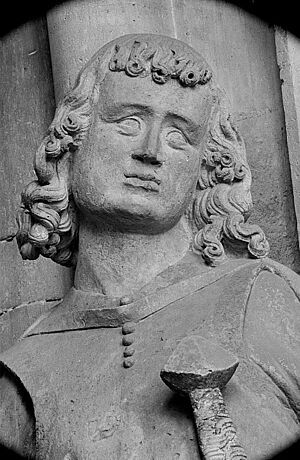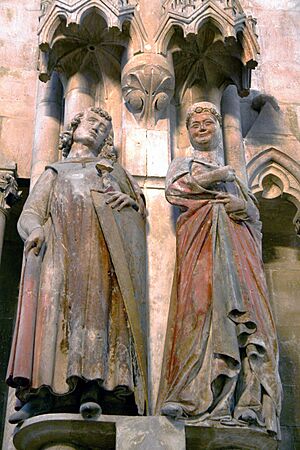Herman I, Margrave of Meissen facts for kids
Quick facts for kids Herman I |
|
|---|---|
| Margrave of Meissen | |
 |
|
| Donor portrait at Naumburg Cathedral | |
| Spouse(s) | Regelinda |
| Noble family | Ekkeharding |
| Father | Eckard I, Margrave of Meissen |
| Mother | Suanhild of Billung |
| Born | c. 980 |
| Died | 1 November 1038 |
Herman I (born around 980, died November 1, 1038) was an important ruler known as the Margrave of Meissen. He held this powerful position from 1009 until he passed away.
Early Life and Family
Herman was the oldest son of Margrave Eckard I of Meissen. His mother was Swanehilde, whose father was Hermann Billung.
In 1002, a sad event happened. Herman's father, Margrave Eckard I, was murdered. This happened after his father had tried to become the German king. After this, the new king, Henry II, gave the title of Margrave of Meissen to Herman's uncle, Gunzelin. Herman and his brother had to go back to their family lands.
In the summer of 1002, Herman married Regelinda. She was the daughter of the Polish king, Bolesław I the Brave. This marriage was important because it connected Herman to the powerful Polish Piast dynasty. This connection helped Herman gain more influence.
Becoming Margrave
During a war between Germany and Poland in 1007, Herman was made the count of Bautzen. He and his younger brother, Eckard II, had a big disagreement with their uncle Gunzelin. This was a difficult family conflict.
Things changed in 1009. King Henry II decided to remove Margrave Gunzelin from his position. Gunzelin was arrested. Herman was chosen to replace him as Margrave of Meissen. Herman had a better relationship with the king than Gunzelin did.
Loyalty and Conflicts
Margrave Herman became a very loyal supporter of the next German emperor, Conrad II. In 1029, Herman was given more titles and lands.
He sent his soldiers to fight against the Polish king, Mieszko II Lambert. Their goal was to win back lands that Poland had taken. This conflict ended with the Treaty of Merseburg in 1033. Herman also had disagreements with other powerful people, like the Thuringian count William III of Weimar and Bishop Thietmar of Merseburg.
In his later years, Herman allowed his younger brother, Eckard II, to take over more of the ruling duties. When Herman died in 1038, Eckard II became the next Margrave of Meissen.
Images for kids




